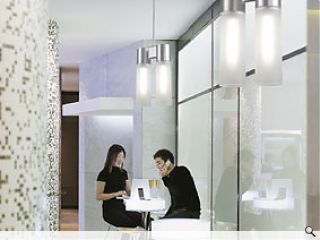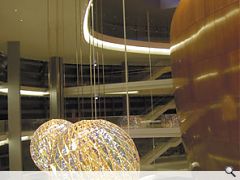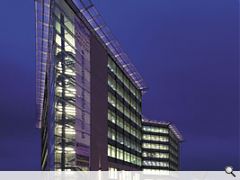Lighting
24 Feb 2006
Mike Stoane From humble beginnings to practice defining work on the Museum of Scotland, MSL have put their faith
in function and simplicity of form. In a market where the
word Scandinavian is a byword for the very virtues MSL champion, they have bucked the trend by working on some of the most prestigious contracts across the North Sea.
Mike Stoane Lighting (MSL) is ten years old this year. The company, which started life with Stoane working alone from a Granton lockup, now operates out of a purpose-built factory and workshop on Bilston Glen Industrial Estate in Loanhead and employs 20 people. Although its capabilities have increased dramatically, it remains true to its roots by providing a flexible and personal service.
All of MSL’s lights are designed and manufactured in Scotland. While competitors subcontract to China, or worse, import semi or fully-finished products, MSL firmly believes that manufacturing in the UK allows it to produce superior quality products with greater flexibility.
“The MSL design aesthetic is based around function, method of manufacture and the belief that elegance comes from simplicity of form, not from unnecessary decoration,” says Stoane. Products are distinctive because of their simple, crisp, clean appearance. MSL has developed into a recognisable brand. The MSL range combines a sharpness and a modernist flavour associated with the larger functional components with much more delicate elements in a way that creates vital and often glamorous fittings. In the past month I have visited several buildings, including the new Royal Bank of Scotland at Gogarburn, in which Stoane’s fittings were instantly recognisable. “Ours is a brand that is about more than just the aesthetic though,” says Stoane. “It\'s also about a unique approach to design and manufacture, intelligent service and it is about the relationships we have formed with architects and lighting designers. Rather than speculatively developing products we believe in listening to and working with our customers to develop products that do exactly what is required,” he adds.
MSL’s portfolio of projects is impressive. Since the early days, Stoane has been involved in Scotland’s most significant projects, beginning with the Museum of Scotland, which was an important turning point for the company. Kevan Shaw, the lighting designer, put his trust in what was then a very small company to take on a large and prestigious project. Between them, Shaw and Stoane developed MLX, which is now understood to be the best museum track spot on the market. MLX has since been used throughout major museums worldwide.
Export, mainly to the Middle East and Europe, forms a comparatively large part of the business. In a reversal of the trend, while Scandinavian design is being imported en masse to the UK, MSL\'s fittings, designed and manufactured in Scotland, are being successfully exported to Scandinavia. The first big Scandinavian project, with lighting designers Speirs and Major, featured a version of the high-spec lockable recessed down light, ADL, modified to suit the architectural and acoustic requirements of the new Copenhagen Opera House. Since then they have completed major Scandinavian projects such as the Museum of World Culture in Gothenburg, Tietgen Business College in Denmark and Volvo Trucks in Sweden.
The range of MSL products that has been developed over the last ten years is impressive and available to view and download from its website (www.mikestoanelighting.com). Despite the success, MSL is determined not to become complacent. “The creative force behind the company comes from the challenges they are set by architects and lighting designers,” says Stoane. “I am determined that we remain as flexible and passionate about what we do as we were in the early days.”
Real Light Too often architects imagine that their work will be evenly illuminated. A new book doesn’t just compile the work by Spiers and Major Associates on Bath Spa, the new Danish Opera House and the Gherkin. It tours the world and finds inspiration in the Alhambra and the Parthenon.
Scotland is justly celebrated for the luminous quality of its light, something long recognised by visiting artists such as JMW Turner, James Turrell and Jon Schueler. Branded a second generation abstract expressionist, Schueler fell for the isolated fishing village of Mallaig in 1957 as a bulkhead against prevailing American vulgarity (as he saw it). The light here continues to beguile, but then, who can resist the emotional intensity of a Scottish sunset?
Certainly not Jonathan Spiers and Mark Major, who studied architecture in Edinburgh in the early 1980s but both eventually elided out of architecture per se into the lighting of architecture. Their lighting design company, Spiers + Major Associates (SaMA), was formed in 1992 and operates from Dean Village in Edinburgh (and London). The list of collaborative projects is impressive and includes Larsen’s Opera House in Copenhagen, Grimshaw’s Bath Spa, Foster’s 30 St Mary Axe and Atkins’ Burg Al Arab in Dubai. This new publication, Made of Light, gathers together some of this work and follows on from a touring exhibition of the same name launched at RIBA in March 2004, and an associated website www.madeoflight.com.
Fortunately, Made of Light is no dusty textbook. Here is a book with no index, where you will find no dry diagrams, no obtuse data or impenetrable formulae involving lux levels on the working plane. Instead we are offered a journey from burning branch to colour-changing diodes. Our itinerary encompasses everything from the Moorish vaults of the Alhambra to the Pantheon’s oculus to Moholy-Nagy’s Light Space Modulator. The authors assure us that this book is neither primer nor polemic, and employ over 440 colour photographs to demonstrate their appreciation of our world, its architecture and their (particular) contribution to its development.
Research suggests that one has all of three seconds to capture a potential client’s attention with any practice brochure. The veracity of such a claim is perhaps open to some speculation, but no-one would underplay the importance of such promotional material in establishing/confirming your standing in the marketplace.
So is Made of Light little more than a sophisticated practice brochure? Certainly there are numerous parallels if you download SaMA’s 28-page brochure from the net but the book is much more than an “entertaining overview”. Its ambition is to promote light, both natural and artificial, by emphasising its poetic qualities rather than its instrumental characteristics. It is a book of magical images, supported by philosophical musings, intended to inspire. The approach is accessible and the aim is to engender trust and respect for an oft-overlooked aspect of architecture.
Le Corbusier may have proclaimed architecture to be the “…masterly, correct and magnificent play of masses brought together in light” but Spiers argues that most architects rarely progress beyond the ‘white model’, where the building is “…just lit from an imaginary source that casts no shadows and each surface is evenly illuminated”. Perhaps Made of Light will not banish such myopia completely but we are indebted to Spiers + Major for affording us the means to extend our understanding of such a fundamental element.
Two Tone Single light sources just don’t do the business, either in office or commercial interiors. A number of manufacturers are dedicated to make environments more relaxed and, as research shows, more productive.
“When they have a choice,” wrote Christopher Alexander, “people will always gravitate to those rooms which have light on two sides, and leave the rooms which are lit only from one side unused and empty.” Alexander created the pattern language system, which has been as influential on the world of computing as it has on the world of architecture. Alexander’s work A Pattern Language described a practical architectural system in a form that a computer scientist might call a generative grammar. He observed that many medieval cities are harmonious and ascribed this to local regulations that required specific features, but freed builders to adapt them. It was a complex theory based on keeping things simple.
In turn, Alexander also noted the simple ways that people respond to variety – one kind of light just isn’t enough. Like many of Alexander’s theories this theoretical understanding is filtering its way into the market. In the USA, the Light Right Consortium – an independent research organisation – set out to discover if different lighting environments affected performance. A standard office layout was designed and volunteers were asked to complete tasks under different types of lighting. Ninety-one per cent of the volunteers liked a system that was based on a combination of direct and indirect lighting, combined with wall washing and dimming control. This system also produced the best results in terms of accuracy and speed at completing the tasks.
According to Harry Barnitt from Zumtobel Staff Lighting, other research proved that workers also prefer lighting that mimics exterior conditions and that also provides a degree of ‘cool’ light. “The implications of the research are that good office design should ideally have direct/indirect lighting systems with wall washing, have forms of control that allow for varying light levels, distribution patterns and colour temperature, and incorporate some form of local control,” he said. Flexibility is also the watchword for other interior lighting, suggests Zumtobel’s Neil Southerd, design consultant for the London restaurant Deep.
Even on a project that apparently sits at the most opulent end of the market, lighting designers are beginning to understand the need for lighting to have a dual action. Speirs and Major Associates (see book review on previous page) suggested the introduction of an ultra-traditional light source in the shape of a chandelier for the UK Government Offices at Great George Street. However, it wanted to make it a modern one. Iguzzini reworked the core principals of the fitting. A series of secondary reflecting rings suspended below a number of light sources allowed a percentage of the light to pass straight through. The remainder was reflected back on to the domed ceiling and vertical surfaces of the main entrance of the Inland Revenue and Customs and Excise building (East End).
New technology is, of course, aiding our ability to be flexible with light; to provide diffuse light alongside direct sources. BFI Optilas distributes a system with the psychedelic soubriquet of LSDs. Unlike their namesake, these LSDs, manufactured from thin film substrates such as polycarbonate or polyester sheets, provide uniform colour. LSDs work as diffusers for any kind of light, independent of its wavelength or source. Companies such as Hacel Lighting are able to meet this increased requirement for range and combination in lighting strategies. Hacel distributes its products throughout Europe, the Middle East, and Australia from its 4,000-square-metre headquarters near Newcastle upon Tyne in the north of England. Its 2006 range of Hacel luminaires stretches to 414 colour pages. Volume is just one means though of providing the dual sources of light that are required in contemporary work and leisure spaces.
In domestic projects, it is rarely the architect who tells the client were to put lamps but given the increasing popularity of lighting companies operating at lower costs over the internet, the ability to purchase iconic contemporary design in this field has been greatly increased. Ic\'ne Limited sell leading brands such as Flos, Bestlite, Anglepoise, Alessi and Allegra Hicks on-line.
It completes a nice circle for the work of the late Robert Dudley Best who, influenced by Bauhaus introduced a stylish modern range to a traditional business back in the 1920s. The first lamps however were sold to auto repair shops, where they were appreciated for their functionality. However when Winston Churchill chose the Bestlite for his desk in Whitehall, its functional modernism gained a definite air of classical respectability. The respect for functionality exhibited by Bestlite has been carried through by Ic\'ne. The company is also responding to the needs of architects and designers and so part of their service includes providing technical data for each product and expertise in sourcing products to fit design schemes. Christopher Alexander’s lighting strategy looks conservative in comparison.
|
|
Read next: Timber
Read previous: A Parisian Flaneur
Back to February 2006
Browse Features Archive
Search
News
For more news from the industry visit our News section.
Features & Reports
For more information from the industry visit our Features & Reports section.





